| The Origin and Nature of the Emotions: Miscellaneous Papers | ||
THE ORIGIN AND NATURE OF THE EMOTIONS
PHYLOGENETIC ASSOCIATION IN RELATION TO CERTAIN
MEDICAL PROBLEMS[1]
The discovery of the anesthetic properties of ether and its practical application to surgery must always stand as one of the great achievements of medicine. It is eminently fitting that the anniversary of that notable day, when the possibilities of ether were first made known to the world, should be celebrated within these walls, and whatever the topic of your Ether Day orator, he must fittingly pause first to pay tribute to that great event and to the master surgeons of the Massachusetts General Hospital. On this occasion, on behalf of the dumb animals as well as on behalf of suffering humanity, I express a deep sense of gratitude for the blessings of anesthesia.
Two years ago, an historic appreciation of the discovery of ether was presented here by Professor Welch, and last year an address on medical research was given by President Eliot. I, therefore, will not attempt a general address, but will invite your attention to an experimental and clinical study. In presenting the summaries of the large amount of data in these researches, I acknowledge with gratitude the
The scope of this paper may be explained by a concrete example. When a barefoot boy steps on a sharp stone there is an immediate discharge of nervous energy in his effort to escape from the wounding stone. This is not a voluntary act. It is not due to his own personal experience—his ontogeny—but is due to the experience of his progenitors during the vast periods of time required for the evolution of the species to which he belongs, i. e., his phylogeny. The wounding stone made an impression upon the nerve receptors in the foot similar to the innumerable injuries which gave origin to this nerve mechanism itself during the boy's vast phylogenetic or ancestral experience. The stone supplied the phylogenetic association, and the appropriate discharge of nervous energy automatically followed. If the sole of the foot be repeatedly bruised or crushed by a stone, shock may be produced; if the stone be only lightly applied, then the consequent sensation of tickling causes a discharge of nervous energy. In like manner there have been implanted in the body other mechanisms of ancestral or phylogenetic origin whose purpose is the discharge of nervous energy for the good of the individual. In this paper I shall discuss the origin and mode of action of some of these mechanisms and their relation to certain phases of anesthesia.
The word anesthesia—meaning without feeling—describes accurately the effect of ether in anesthetic dosage. Although no pain is felt in operations under inhalation anesthesia, the
There is also strong negative evidence that traumatic impulses are not excluded by ether anesthesia from the part of the brain that is apparently asleep. This evidence is as follows: If the factor of fear be excluded, and if in addition the traumatic impulses be prevented from reaching the brain by cocain[3] blocking, then, despite the intensity or the duration of the trauma within the zone so blocked, there follows no exhaustion after the effect of the anesthetic disappears, and no morphologic changes are noted in the brain-cells.
Still further negative evidence that inhalation anesthesia offers little or no protection to the brain-cells against trauma is derived from the following experiment: A dog whose spinal cord had been divided at the level of the first dorsal segment, and which had then been kept in good condition for two months, showed a recovery of the spinal reflexes, such as the scratch reflex, etc. Such an animal is known as a "spinal dog." Now, in this animal, the abdomen and hind extremities had no direct nerve connection with the brain. In this dog, continuous severe trauma of the abdominal viscera and of the hind extremities lasting for four
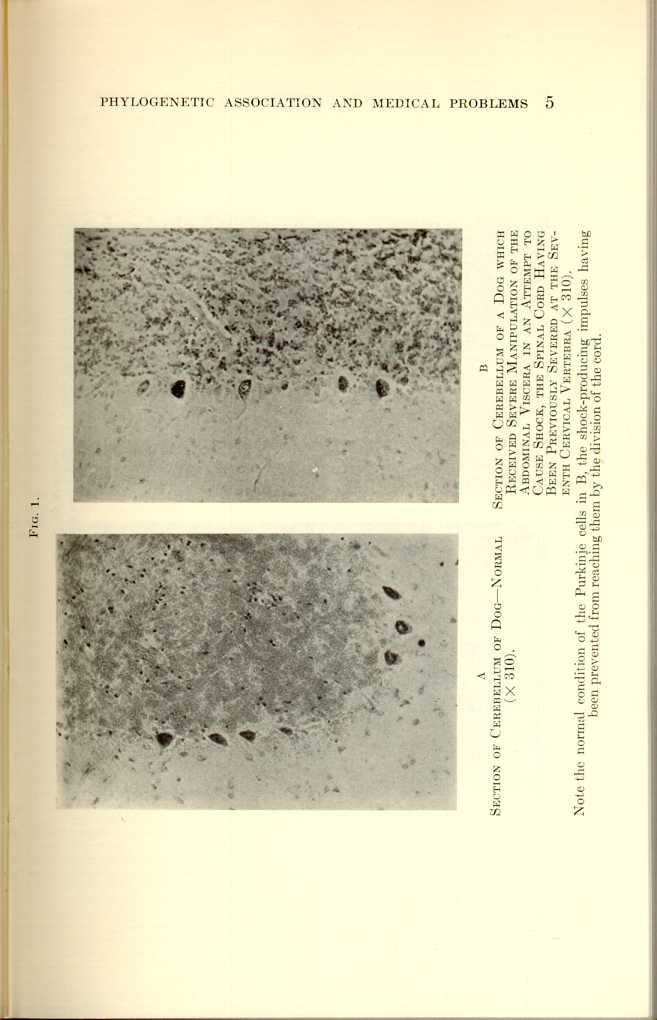
Fig. 1.
A
Section of Cerebellum of Dog—Normal (x310).
B
Section of Cerebellum of a Dog which Received Severe Manipulation of
the Abdominal Viscera in an Attempt to Cause Shock, the Spinal Cord
Having Been Previously Severed at the Seventh Cervical Vertebra
(x310).[a]
[Description: Black and white photos showing microscopic view of cerebellum of a dog
under various conditions.]
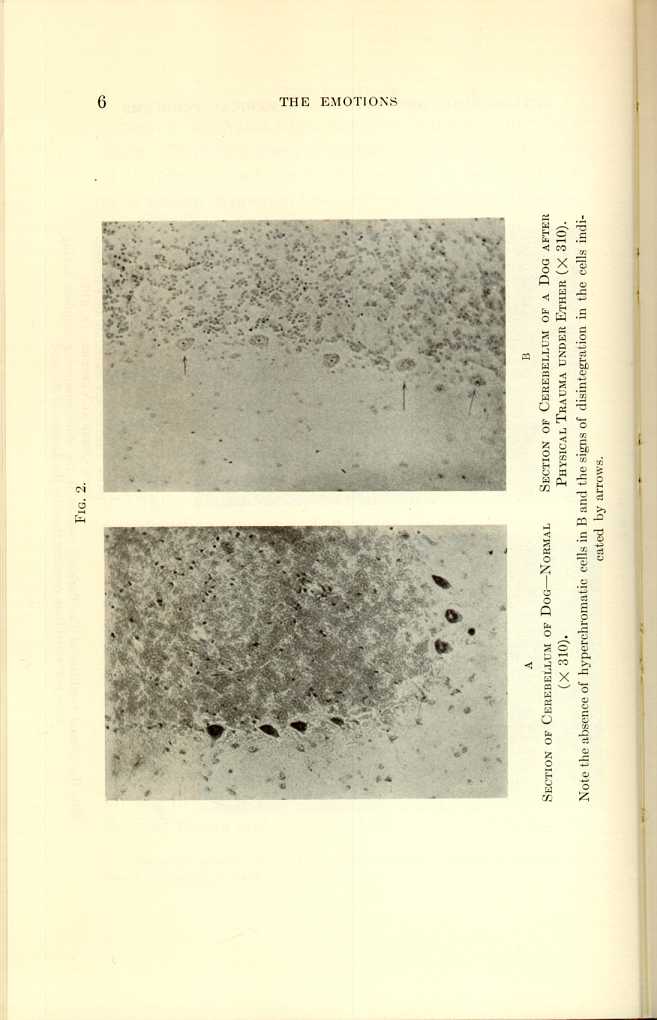
Fig. 2.
A
Section of Cerebellum of Dog—Normal (x310).
B
Section of Cerebellum of Dog after Physical Trauma under Ether
(x310).[b]
[Description: Black and white photos showing microscopic view of cerebellum of a dog
under various conditions.]
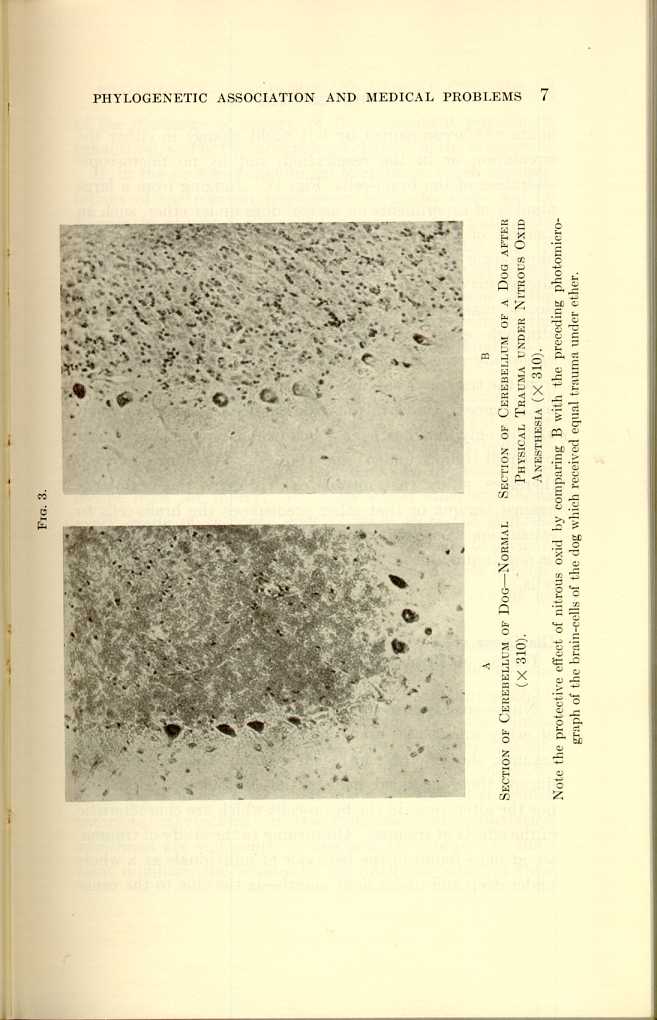
Fig. 3.
A
Section of Cerebellum of Dog—Normal (x310).
B
Section of Cerebellum of Dog after Physical Trauma under Nitrous Oxid
Anesthesia (x310).[c]
[Description: Black and white photos showing microscopic view of cerebellum
of a dog under various conditions.]
The Cause of the Exhaustion of the Brain-cells as a Result of Trauma of Various Parts of the Body under Inhalation Anesthesia
Numerous experiments on animals to determine the effect of ether anesthesia per se, i. e., ether anesthesia without trauma, showed that, although certain changes were produced, these included neither the physiologic exhaustion nor the alterations in the brain-cells which are characteristic of the effects of trauma. On turning to the study of trauma, we at once found in the behavior of individuals as a whole under deep and under light anesthesia the clue to the cause
If, in the course of abdominal operations, rough manipulations of the parietal peritoneum be made, there will be frequently observed a marked increase in the respiratory rate and an increase in the expiratory force which may be marked by the production of an audible expiratory groan. Under light ether anesthesia, severe manipulations of the peritoneum often cause such vigorous contractions of the abdominal muscles that the operator is greatly hindered in his work.
Among the unconscious responses to trauma under ether anesthesia are purposeless moving, the withdrawal of the injured part, and, if the anesthesia be sufficiently light and the trauma sufficiently strong, there may be an effort toward escape from the injury. In injury under ether anesthesia every grade of response may be seen, from the slightest change in the respiration or in the blood-pressure to a vigorous defensive struggle. As to the purpose of these subconscious movements in response to injury, there can be no doubt—they are efforts to escape from the injury.
Picture what would be the result of a formidable abdominal operation extending over a period of half an hour or more on an unanesthetized human patient, during which extensive adhesions had been broken up, or a large tumor dislodged from its bed! In such a case, would not the nervous system discharge its energy to the utmost in efforts to escape from the injury, and would not the patient suffer complete exhaustion? If the traumata under inhalation anesthesia are sufficiently strong and are repeated in sufficient numbers, the brain-cells are finally deprived of their
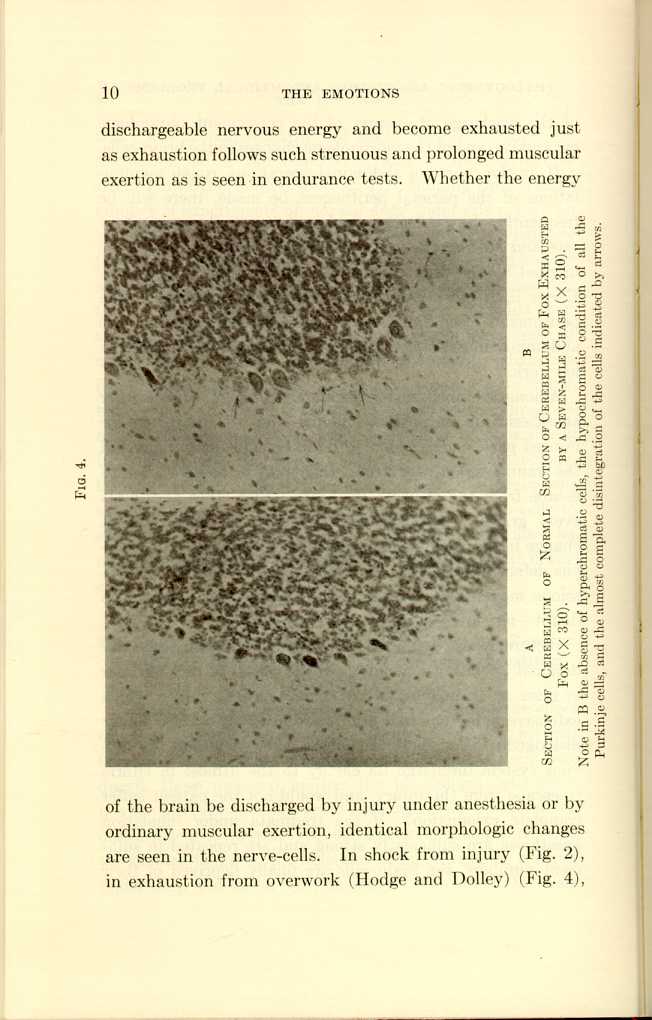
Fig. 4.
A
Section of Cerebellum of Normal Fox (x310).
B
Section of Cerebellum of Normal Fox Exhausted by a Seven-Mile chase
(x310).[d]
[Description: Black and white photos showing microscopic view of cerebellum
of a fox under various conditions.]
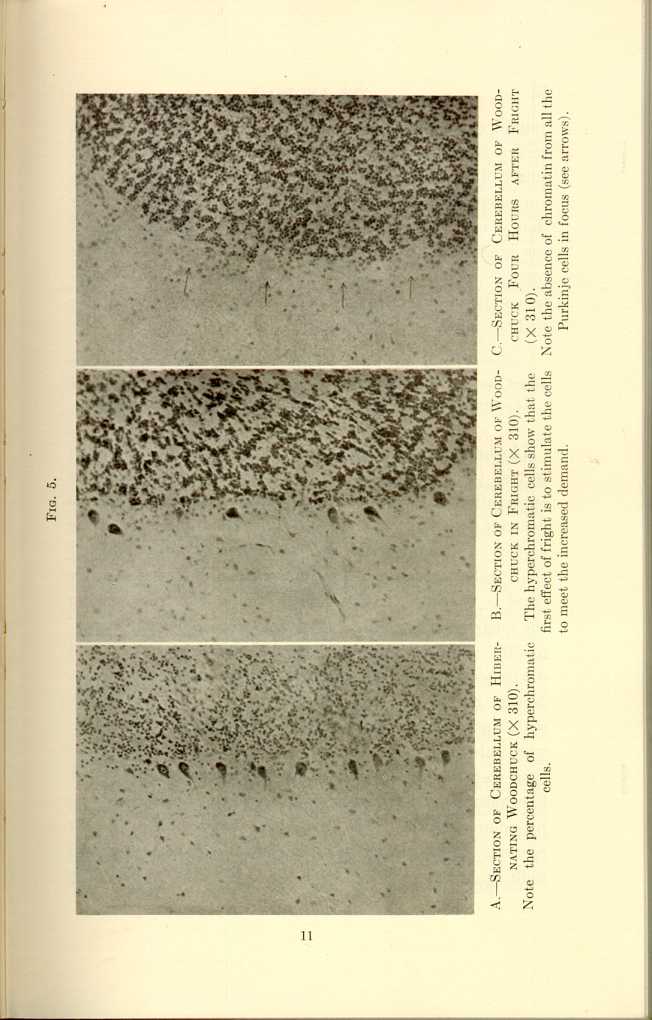
Fig. 5.
A
Section of Cerebellum of Hybernating Woodchuck
(x310).[e]
B
Section of Cerebellum of Woodchuck in Fright
(x310).[f]
C
Section of Cerebellum of Woodchuck Four Hours after Fright
(x310).[g]
[Description: Black and white photos showing microscopic view of cerebellum
of a woodchuck under various conditions.]
The Cause of the Discharge of Nervous Energy as a Result of Trauma under Inhalation Anesthesia and under Normal Conditions
I looked into this problem from many viewpoints and there seemed to be no solution until it occurred to me to seek the explanation in certain of the postulates which make up the doctrine of evolution. I realize fully the difficulty and the danger in attempting to reach the generalization which I shall make later and in the hypothesis I shall propose, for there is, of course, no direct final proof of the truth of even the doctrine of evolution. It is idle to consider any experimental research into the cause of phenomena that have developed by natural selection during millions of years. Nature herself has made the experiments on a world-wide scale and the data are before us for interpretation. Darwin could do no more than to collect all available facts and then to frame the hypothesis by which the facts were best harmonized. Sherrington, that masterly physiologist, in his volume entitled "The Integrative Action of the Nervous System," shows clearly how the central nervous system was built up in the process of evolution. Sherrington has made
According to the doctrine of evolution, every function owes its origin to natural selection in the struggle for existence. In the lower and simpler forms of animal life, indeed, in our human progenitors as well, existence depended principally upon the success with which three great purposes were achieved: (1) Self-defense against or escape from enemies; (2) the acquisition of food; and (3) procreation; and these were virtually the only purposes for which nervous energy was discharged. In its last analysis, in a biologic sense, this statement holds true of man today. Disregarding for the present the expenditure of energy for procuring food and for procreation, let us consider the discharge of energy for self-preservation. The mechanisms for self-defense which we now possess were developed in the course of vast periods of time through innumerable intermediary stages from those possessed by the lowest forms of life. One would suppose, therefore, that we must now be in possession of mechanisms which still discharge energy on adequate stimulation, but which are not suited to our present needs. We shall point out some examples of such unnecessary mechanisms. As Sherrington has stated, our skin, in which are implanted
On the basis of natural selection, nociceptors could have developed in only those regions of the body which have been exposed to injury during long periods of time. On this ground the finger, because it is exposed, should have many nociceptors, while the brain, though the most important organ of the body, should have no nociceptors because, during a vast period of time, it has been protected by a skull. Realizing that this point is a crucial one, Dr. Sloan and I made a series of careful experiments. The cerebral hemispheres of dogs were exposed by removing the skull and dura under ether and local anesthesia. Then various portions of the hemispheres were slowly but completely destroyed by rubbing them with pieces of gauze. In some instances a hemisphere was destroyed by burning. In no case was there more than a slight response of the centers governing circulation and respiration, and no morphologic change was noted in an histologic study of the brain-cells of the uninjured hemisphere. The experiment was as completely negative as were the experiments on the "spinal dog." Clinically I have confirmed these experimental findings
Because it is such a commonplace observation, one scarcely realizes the importance of the fact that clean-cut wounds inflicted by a razor-like knife cause the least reaction, while a tearing, crushing trauma causes the greatest response. It is a suggestive fact that the greatest shock is produced by any technic which imitates the methods of attack and of slaughter used by the carnivora. In the course of evolution, injuries thus produced may well have been the predominating type of traumata to which our progenitors were subjected. In one particular respect there is an analogy between the
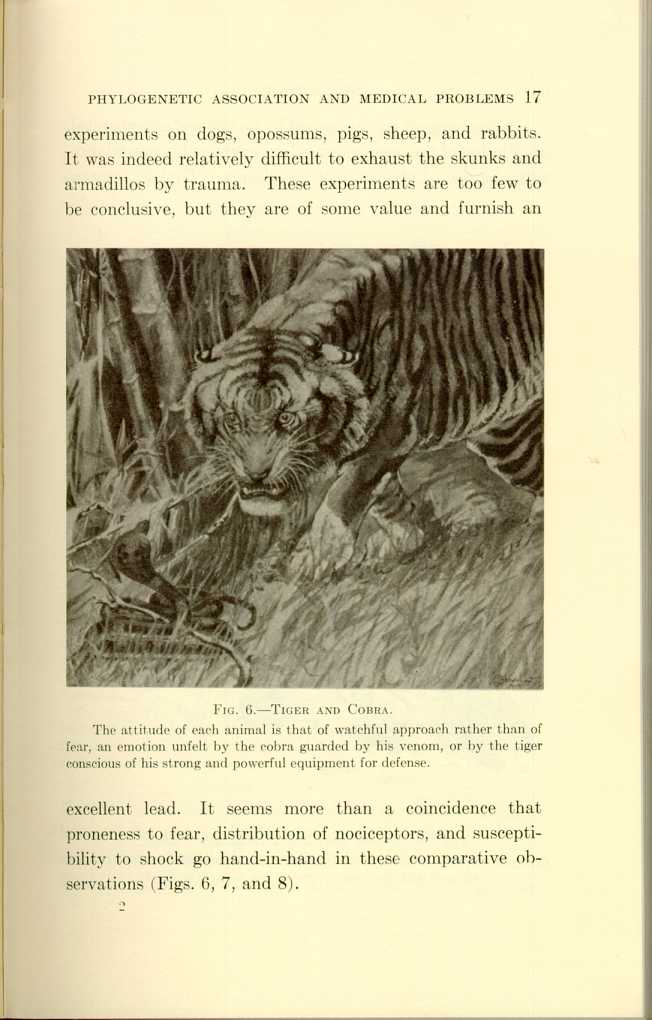
FIG. 6.—TIGER AND COBRA.[h]
[Description: Black and white illustration of a tiger and a cobra facing off.]The discharge of energy caused by an adequate mechanical
stimulation of the nociceptors is best explained in accordance
with the law of phylogenetic association. That is, injuries
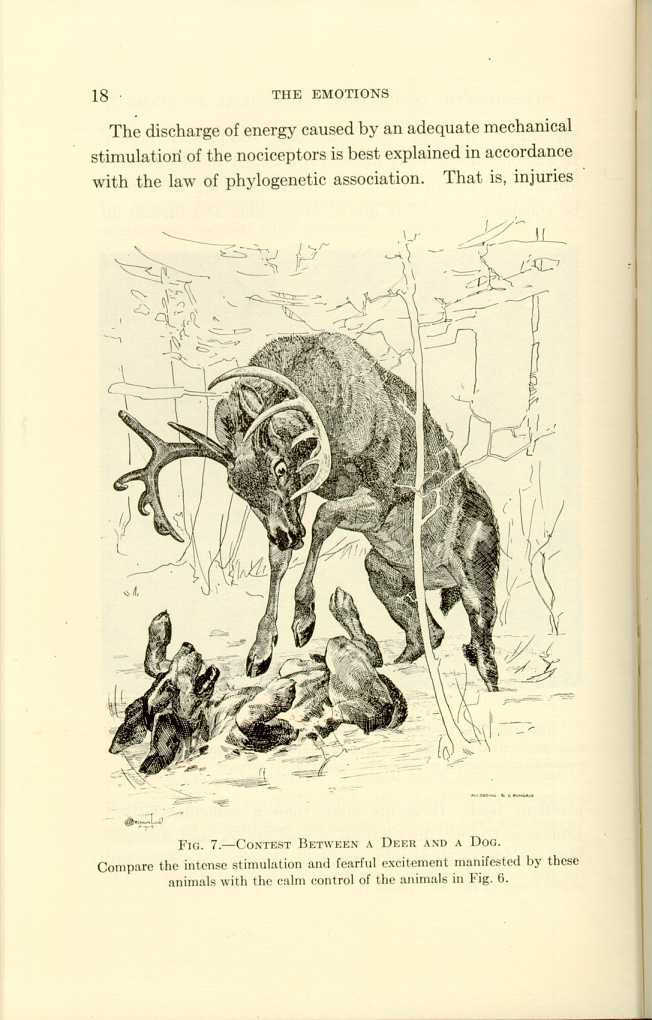
FIG. 7.—CONTEST BETWEEN A DEER AND A
DOG.[i]
[Description: Black and white illustration of a deer and a dog fighting.]
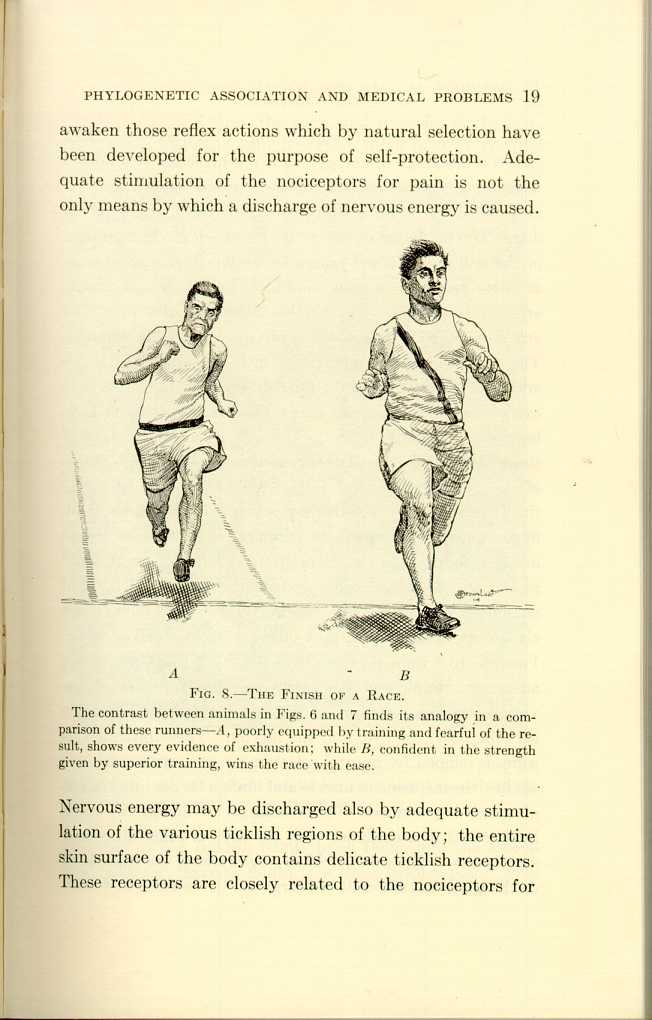
FIG. 8—THE FINISH OF A RACE.[j]
[Description: Black and white illustration of two men finishing a foot-race.]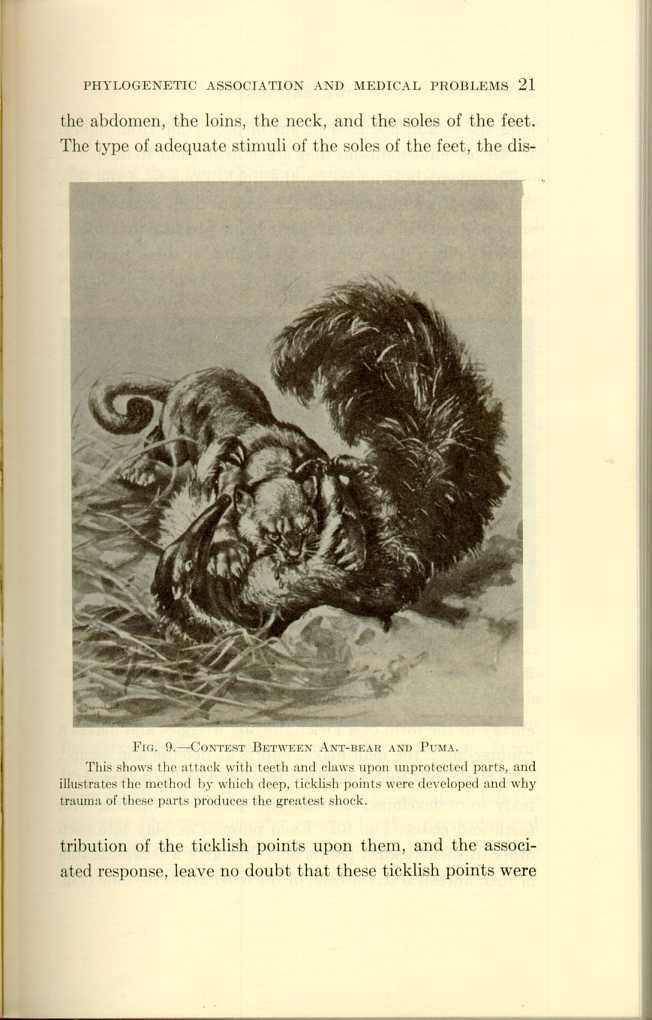
FIG. 9—CONTEST BETWEEN ANT-BEAR AND PUMA.
This shows the attack with teeth and claws upon unprotected parts, and
illustrates the method by which deep, ticklish points were developed and why
trauma of these parts produces the greatest shock.
[Description: Black-and-white illustration showing a puma biting and clawing
an ant-eater in the chest.]
The adequate stimulus for the ticklish points of the ribs,
the loins, the abdomen, and the neck is deep isolated pressure,
probably the most adequate being pressure by a
tooth-shaped body. The response to tickling in these regions is
actively and obviously self-defensive. The horse discharges
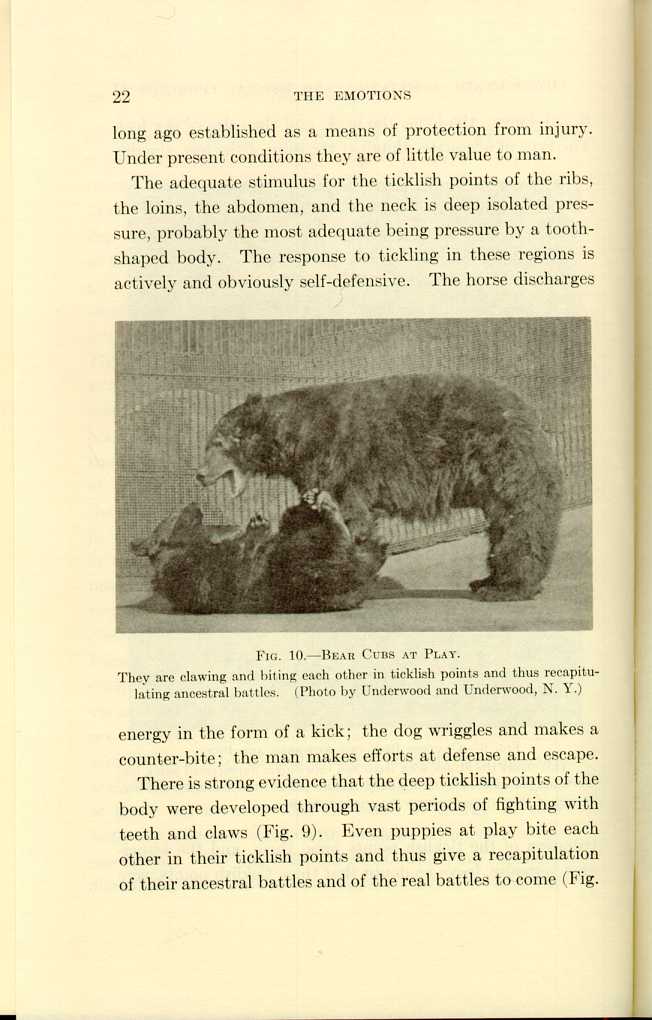
FIG. 10.—BEAR CUBS AT PLAY.
[Description: Black-and-white illustration showing two bears playing roughly.]
They are clawing and biting each other in ticklish points and thus
recapitulating ancestral battles.
(Photo by Underwood and Underwood, N. Y.)
There is strong evidence that the deep ticklish points of the body were developed through vast periods of fighting with teeth and claws (Fig. 9). Even puppies at play bite each other in their ticklish points and thus give a recapitulation of their ancestral battles and of the real battles to come (Fig.
A close analogy to the reflex process in the fighting of animals is shown in the rôle played by the sexual receptors in conjugation. Adequate stimulation of either of these two distinct groups of receptors, the sexual and the noci, causes specific behavior—the one toward embrace, the other toward repulsion. Again, one of the most peremptory causes of the discharge of energy is that due to an attempt to obstruct forcibly the mouth and the nose so that asphyxia is threatened. Under such conditions neither friend nor foe is trusted, and a desperate struggle for air ensues. It will be readily granted that the reactions to prevent suffocation were established for the purpose of self-preservation, but the discharge of nerve-muscular energy to this particular end is no more specific and no more shows adaptive qualities than do the preceding examples. Even the proposal to bind
We have now considered some of the causes of those discharges of nervous energy which result from various types of harmful physical contact, and have referred to the analogous, though antithetical, response to the stimulation of the sexual receptors. The response to the adequate stimuli of each of the several receptors is a discharge of nerve-muscular energy of a specific type; that is, there is one type of response for the ear, one for the larynx, one for the pharynx, another for the nose, another for the eye, another for the deep ticklish points of the chest and the abdomen, quite another for the delicate tickling of the skin, and still another type of response to sexual stimuli.
According to Sherrington, a given receptor has a low threshold for only one, its own specific stimulus, and a high threshold for all others; that is, the doors that guard the nerve-paths to the brain are opened only when the proper password is received. According to Sherrington's law, the individual as a whole responds to but one stimulus at a time, that is, only one stimulus occupies the nerve-paths which carry the impulses as a result of which acts are performed, i. e., the final common path. As soon as a stronger stimulus reaches the brain it dispossesses whatever other stimulus is then occupying the final common path—the path of action. The various receptors have a definite order of precedence over each other (Sherrington). For example, the impulse from the delicate ticklish points of the skin, whose adequate stimulus is an insect-like contact, could not
The Discharge of Energy through Stimulation of the Distance Receptors, or through Representation of Injury (Psychic)
We will now turn from the discussion of the discharge of nervous energy by mechanical stimuli to the discharge of energy through mental perception. Phylogenetic association may result from stimulation of the distance receptors
"Fear is often preceded by astonishment, and is so near akin to it that both lead to the senses of sight and hearing being instantly aroused. In both cases the eyes and mouth are widely opened and the eyebrows raised. The frightened man at first stands like a statue, motionless and breathless, or crouches down as if instinctively to escape observation. The heart beats quickly and violently, so that it palpitates or knocks against the ribs. * * * That the skin is much affected under the sense of great fear we see in the marvelous and inexplicable manner in which perspiration immediately exudes from it. This exudation is all the more
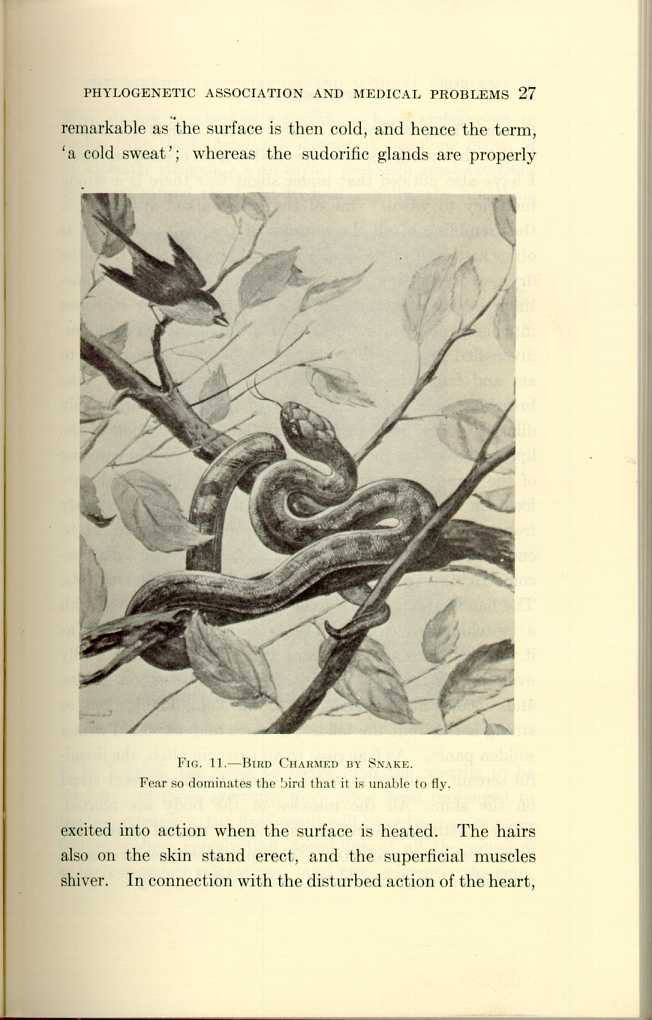
FIG. 11.—BIRD CHARMED BY SNAKE.
Fear so dominates the bird that it is unable to fly.
[Description: Black-and-white illustration showing a small bird and a snake
face-to-face in a tree.]
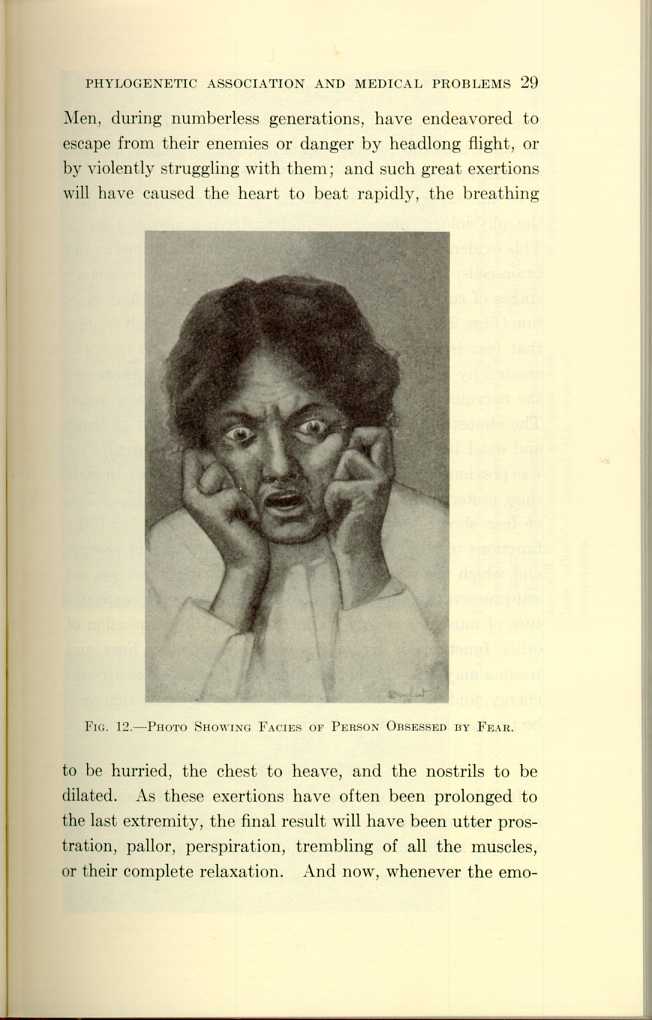
FIG. 12.—PHOTO SHOWING FACIES OF PERSON OBSESSED BY FEAR.
[Description: Black-and-white illustration showing a woman with wide eyes and hands to face.]In an experimental research, we found evidence that the physiologic phenomena of fear have a physical basis. This evidence is found in the morphologic alterations in the brain-cells, which are similar to those observed in certain stages of surgical shock and in fatigue from muscular exertion (Figs. 2, 4, 5, and 13). For the present, we shall assume that fear is a representation of trauma. Because fear was created by trauma, fear causes a discharge of the energy of the nervous system by the law of phylogenetic association. The almost universal fear of snakes, of blood, and of death and dead bodies may have such a phylogenetic origin. It was previously stated that under the stimulus of fear animals show preternatural strength. An analysis of the phenomena of fear shows that, as far as can be determined, all the functions of the body requiring the expenditure of energy, and which are of no direct assistance in the effort toward self-preservation, are suspended. In the voluntary expenditure of muscular energy, as in the chase, the suspension of other functions is by no means so complete. Fear and trauma may drain to the last dreg the dischargeable nervous energy, and, therefore, the greatest possible exhaustion may be produced by fear and trauma.
Summation
In the discharge of energy, summation plays an important rôle. Summation is attained by the repetition of stimuli at such a rate that each succeeding stimulus is applied before
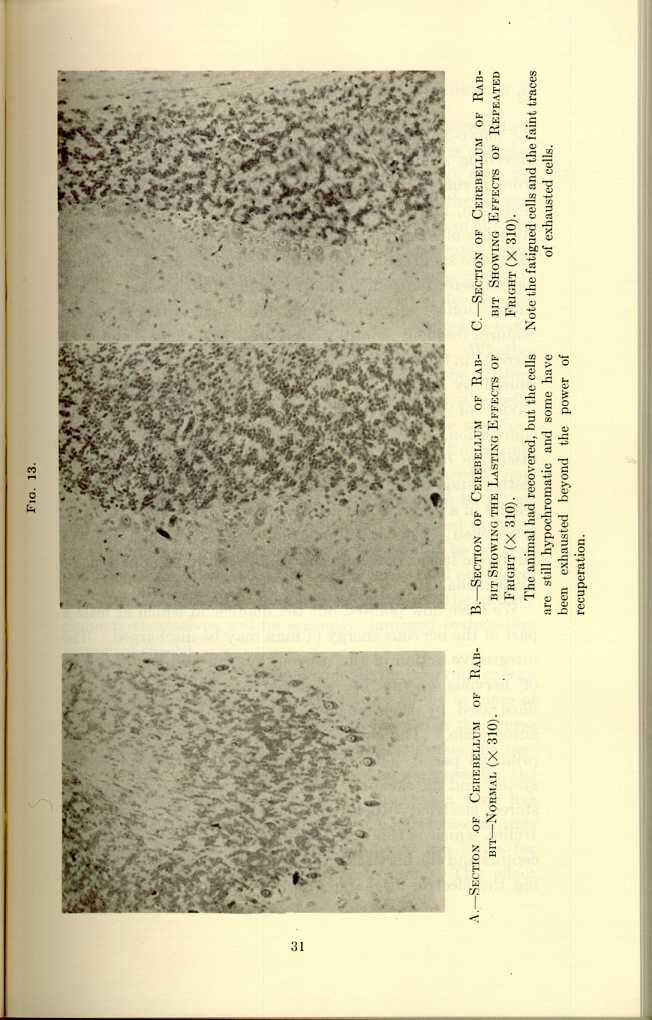
FIG. 13.
A.—Section of Cerebellum of Rabbit—Normal (x310).
B.—Section of Cerebellum of Rabbit Showing the Lasting Effects of
Fright (x310).[k]
C.—Section of Cerebellum of Rabbit Showing Effects of Repeated Fright
(x310).[l]
[Description: Black-and-white photographs of cerebellum of rabbits under
various conditions.]
We have now pointed out the manner in which at least a part of the nervous energy of man may be discharged. The integrative action of the nervous system and the discharge of nervous energy by phylogenetic association may be illustrated by their analogy to the action of an electric automobile. The electric automobile is composed of four principal parts: The motor and the wheels (the muscular system and the skeleton); the cells of the battery containing stored electricity (brain-cells, nervous energy); the controller, which is connected with the cells by wiring (the receptors and the nerve-fibers); and an accelerator for increasing the electric discharge (thyroid gland?). The machine
We have now presented some evidence that nervous energy is discharged by the adequate stimulation of one or more of the various receptors that have been developed in the course of evolution. In response to an adequate stimulus, the nervous system is integrated for a specific purpose by the stimulated receptor, and but one stimulus at a time has possession of the final common path—the nerve mechanisms for action. The most numerous receptors are those for harmful contact; these are the nociceptors. The effect
With this conception, the human body may be likened to a musical instrument—an organ—the keyboard of which is composed of the various receptors, upon which environment plays the many tunes of life; and written within ourselves in symbolic language is the history of our evolution. The skin may be the "Rosetta Stone" which furnishes the key.
Anoci-association
By the law of phylogenetic association, we are now prepared to make a practical application of the principles of the discharge of nervous energy. In the case of a surgical operation, if fear be excluded and if the nerve-paths between the field of operation and the brain be blocked with cocain,[5] no discharge of energy will be caused by the operation; hence no shock, no exhaustion, can result. Under such conditions the nervous system is protected against noci-association, resulting from noci-perception or from an adequate stimulation of nociceptors. The state of the patient in whom all noci-associations are excluded can be described only by coining a new word. That word is "anoci-association" (Fig. 14).
The difference between anesthesia and anoci-association is that, although inhalation anesthesia confers the beneficent loss of consciousness and freedom from pain, it does not prevent the nerve impulses from reaching and influencing the brain, and therefore does not prevent surgical shock nor the train of later nervous impairments so well described by Mumford. Anoci-association excludes fear, pain, shock, and post-operative
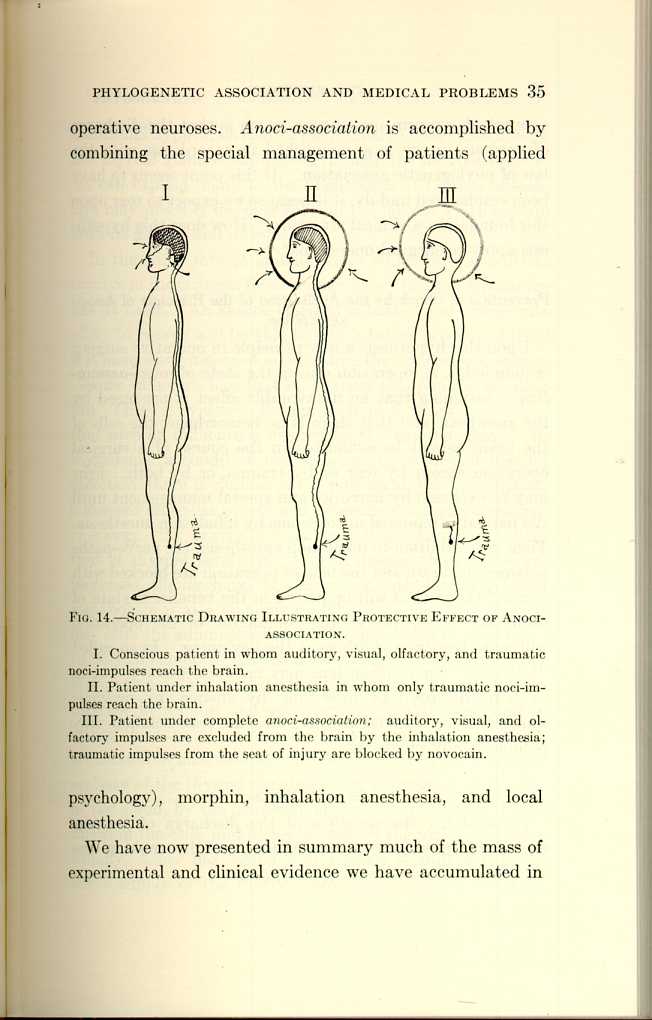
FIG. 14.—SCHEMATIC DRAWING ILLUSTRATING PROTECTIVE EFFECT OF
ANOCI-ASSOCIATION.
I. Conscious patient in whom auditory, visual, olfactory, and traumatic
noci-impulses reach the brain.
II. Patient under inhalation anesthesia in whom only traumatic
noci-impulses reach the brain.
III. Patient under complete anoci-association; auditory, visual, and
olfactory impulses are excluded from the brain by the inhalation anesthesia;
traumatic impulses from the seat of injury are blocked by novocain.
[Description: Black-and-white illustration in three parts showing person with
trauma to leg under various states of anesthesia.]
We have now presented in summary much of the mass of experimental and clinical evidence we have accumulated in
Prevention of Shock by the Application of the Principle of Anoci-association
Upon this hypothesis a new principle in operative surgery is founded, i. e., operation during the state of anoci-association. Assuming that no unfavorable effect is produced by the anesthetic and that there is no hemorrhage, the cells of the brain cannot be exhausted in the course of a surgical operation except by fear or by trauma, or by both. Fear may be excluded by narcotics and special management until the patient is rendered unconscious by inhalation anesthesia. Then if, in addition to inhalation anesthesia, the nerve-paths between the brain and the field of operation are blocked with cocain,[6] the patient will be placed in the beneficent state of anoci-association, and at the completion of the operation will be as free from shock as at the beginning. In so-called "fair risks" such precautions may not be necessary, but in cases handicapped by infections, by anemia, by previous shock, and by Graves' disease, etc., anoci-association may become vitally important.
Graves' Disease
By applying the principle of the discharge of nervous energy by phylogenetic association, and by making the
In the wild state of animal life in which only the fittest survive in the struggle for existence, every point of advantage has its value. An animal engaged in battle or in a desperate effort to escape will be able to give a better account of itself if it have some means of accelerating the discharge of energy—some influence like that of pouring oil upon the kindling fire. There is evidence, though perhaps it is not conclusive, that such an influence is exerted by the thyroid gland. In myxedema, a condition characterized by a lack of thyroid secretion, there is dulness of the reflexes and of the intellect, a lowered muscular power, and generally a sluggish discharge of energy. In Graves' disease there is an excessive production of thyroid secretion. In this disease the reflexes are increased, the discharge of energy is greatly facilitated, and metabolism is at a maximum. The same phenomena occur also after the administration of thyroid extract in large doses to normal subjects. In the course of sexual activities there is an increased action of the thyroid, which is indicated by an increase in its size and vascularity. That in fear and in injury the thyroid, in cases of Graves' disease, is probably stimulated to increased activity is indicated by the increased activity of the thyroid circulation, by an increase in the size of the gland, by the histologic appearance of activity in the nuclei of the cells, and by an increase of the toxic symptoms. Finally, Asher has stated that electric stimulation of the nerve supply of the thyroid causes an increased secretion.
I have never known a case of Graves' disease to be caused by success or happiness alone, or by hard physical labor unattended by psychic strain, or to be the result of energy voluntarily discharged. Some cases seem to have had their origin in overdosage with thyroid extract in too vigorous an attempt to cure a colloid goiter. One of the most striking characteristics of Graves' disease is the patient's loss of control and his increased susceptibility to stimuli, especially to trauma and to fear and to the administration of thyroid extract. It has been shown that the various causes of the discharge of nervous energy produce alterations in the nervous system and probably in the thyroid gland. This is especially true of the fear stimulus, and has been clearly demonstrated in the brains of rabbits which had been subjected to fear alone (Fig. 13). Of special interest was the effect of daily fright. In this case the brain-cells showed a distinct change, although the animal had been subjected to no fear for twenty-four hours before it was killed (Fig. 13 C.
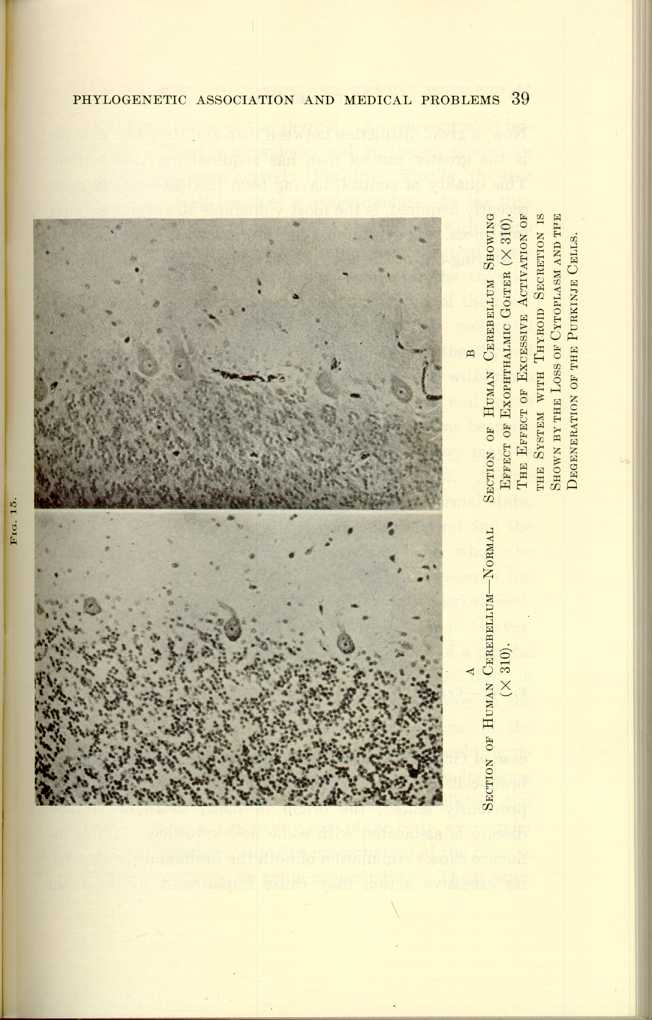
FIG. 15
A: Section of Human Cerebellum—Normal (x310).
B: Section of Human Cerebellum Showing Effect of Exophthalmic Goiter
(x310). The Effect of Excessive Activation of the System with Thyroid
Secretion is Shown by the Loss of Cytoplasm and the Degeneration of the
Purkinje Cells.
[Description: Black-and-white photographs showing sections of human
cerebellum under various conditions.]
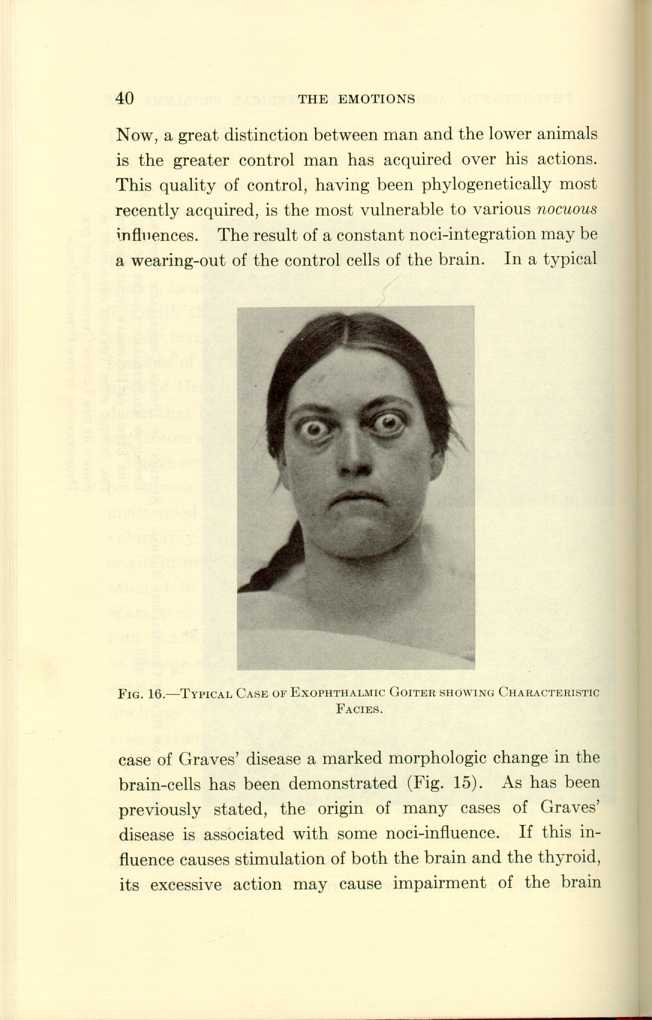
FIG. 16—TYPICAL CASE OF EXOPHTHALMIC GOITER SHOWING CHARACTERISTIC FACIES.
[Description: Black-and-white photograph of woman with bulging eyes.]In applying the principle of anoci-association in operations on
patients with Graves' disease there is scarcely a change in the pulse,
in the respiration, or in the nervous state at the close of the
operation. I know no remedy which can obviate the effect of the
inflowing stimuli from the wound after the
cocain[7] has worn
off.[8] It is necessary,
therefore,
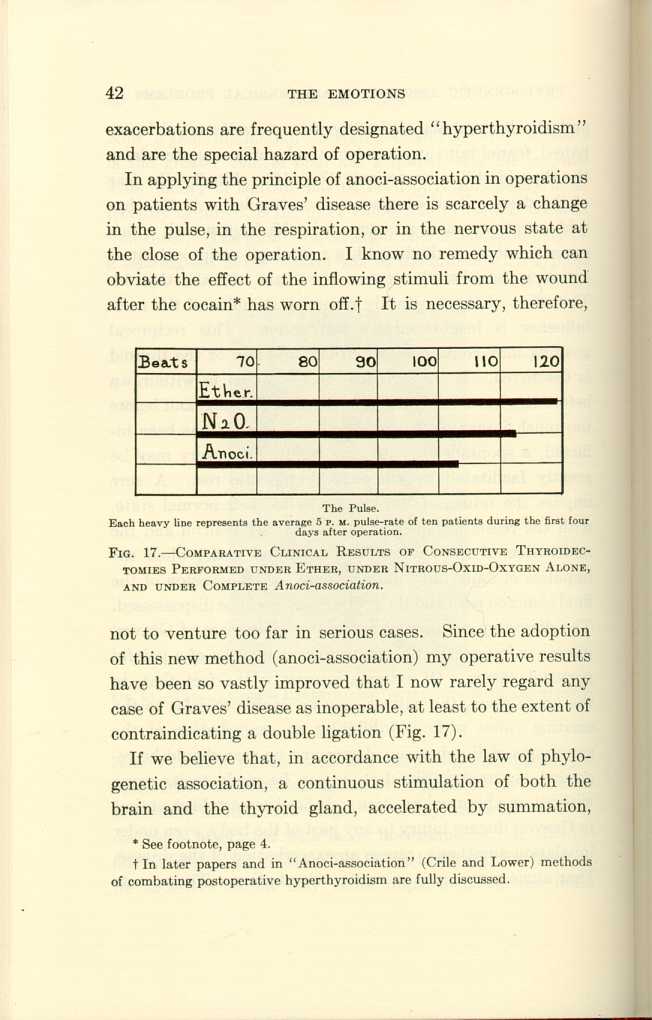
The Pulse.
[Description: Black-and-white illustration: bar graph.]
Each heavy line represents the average 5 P. M. pulse-rate of ten
patients during the first four days after operation.
FIG. 17.—COMPARATIVE CLINICAL RESULTS OF CONSECUTIVE THYROIDECTOMIES
PERFORMED UNDER ETHER, UNDER NITROUS-OXID-OXYGEN ALONE,
AND UNDER COMPLETE Anoci-association.
If we believe that, in accordance with the law of phylogenetic association, a continuous stimulation of both the brain and the thyroid gland, accelerated by summation,
Sexual-Neurasthenia
The state of sexual neurasthenia is in many respects analogous to that of Graves' disease. In the sexual reflexes, summation leads to a hyperexcitability by psychic and mechanical stimuli of a specific type which is analogous to the hyperexcitability in Graves' disease under trauma and fear; the explanation of both conditions is based on the laws of the discharge of energy by phylogenetic association and summation. It would be interesting to observe the effect of interrupting the nerve impulses from the field of the sexual receptors by injections of alcohol, or by other agencies, so as to exclude the associational stimuli until the nervous mechanism has again become restored to its normal condition.
Interpretation of Some of the Phenomena of Certain Diseases of the Abdomen in Accordance with the Hypothesis of Phylogenetic Association
The law of phylogenetic association seems to explain many of the phenomena of certain lesions in the abdominal cavity. The nociceptors in the abdomen, like nociceptors elsewhere, have been established as a result of some kind of injury to which during vast periods of time this region has been frequently exposed. On this premise, we should at once conclude that there are no nociceptors for heat within the abdomen because, during countless years, the intra-abdominal region never came into contact with heat. That this inference is correct is shown by the fact that the application of a thermocautery to the intestines when completing a colostomy in a conscious patient is absolutely painless. One would conclude also that there are no touch receptors in the abdominal viscera, and therefore no sense of touch in the peritoneum. Just as the larynx, the ear, the nose, the sole of the foot, and the skin have all developed the specific type of nociceptors which are adapted for their specific protective purposes, and which, when adequately stimulated, respond in a specific manner in accordance with the law of phylogenetic association, so, the abdominal viscera have developed equally specific nociceptors as a protection against specific nocuous influences. The principal harmful influences to which the abdominal viscera have been exposed during vast periods of time are deep tearing injuries by teeth and claws in the innumerable struggles of our progenitors with each other and with their enemies (Fig. 9); peritonitis caused by perforations of the
As a result of the excitation of nociceptors, with which pain is associated, the routine functions, such as peristalsis, secretion, and absorption are dispossessed from the control of their respective nervous mechanisms, just as they are inhibited by fear. This hypothesis explains the loss of weight, the lassitude, the indigestion, the constipation, and the many alterations in the functions of the various glands and organs of the digestive system in chronic appendicitis. It readily explains also the extraordinary improvement in the digestive functions and the general health which follows the removal of an appendix which is so slightly altered physically that only the clinical results could persuade one that this slight change could be an adequate cause for such far-reaching and important symptoms. This hypothesis
Postoperative and traumatic neuroses are at once explained on the ground of noci-association, the resulting strain from which, upon the brain-cells, causes in them physical lesions. If one were placed against a wall and were looking into the gun muzzles of a squad of soldiers, and were told that there were nine chances out of ten that he would not be killed outright when the volley was fired, would it help him to be told that he must not be afraid? Such an experience would be written indelibly on his brain. This corresponds closely to the position in which some surgical patients are placed. In railway wrecks, we can readily understand the striking difference between the after-effects in the passengers who were conscious at the time of the accident and those who were asleep or drunk. In the latter the noci-perceptors and receptors were not aroused, hence their immunity to the nervous shock. In the functional disturbances of the pelvic organs, association and summation may play a large rôle. On this hypothesis many cases of neurasthenia may well be explained. From the behavior of the individual as a whole we may well conclude that summation is but a scientific expression for "nagging." Many other pathologic phenomena may be explained in a similar manner. Thus we can
Observations on Patients whose Associational Centers are Dulled, and on Diseases and Injuries of Regions not Endowed with Nociceptors
Reversing the order of our reasoning, let us now glance at the patient who is unconscious and who, therefore, has lost much of the power of association. His mouth is usually
In accordance with the law of adaptation through natural selection, phylogeny, and association, one would expect no pain in abscess of the brain, in abscess of the liver, in pylephlebitis, in infection of the hepatic vessels, in endocarditis. This law explains why there are no nociceptors for cancer, while there are active nociceptors for the acute infections. It is because nature has no helpful response to offer against cancer, while in certain of the acute pyogenic infections the nociceptors force the beneficent physiologic rest.
Could we dispossess ourselves of the shackles of psychology, forget its confusing nomenclature, and view the human brain, as Sherrington has said, "as the organ of, and for the adaptation of nervous reaction," many clinical phenomena would appear in a clearer light.
Natural Selection and Chemical Noci-association in the Infections
Thus far we have considered the behavior of the individual as a whole in his response to a certain type of noci-influences. We have been voicing our argument in terms of physical escape from gross physical dangers, or of grappling with gross nerve-muscular enemies of the same or of other species. To explain these phenomena we have invoked the
The administration of vaccines becomes the adequate stimulus which awakens phylogenetic association of a chemical nature as a result of which immune bodies are produced.
In discussing this subject I will raise only the question whether or not the specific character of the inaugural symptoms of some infectious diseases may be due to phylogenetic association. These inaugural symptoms are measurably a recapitulation of the leading phenomena of the disease in its completed clinical picture. Thus, the furious initiative symptoms of pneumonia, of peritonitis, or erysipelas, of the exanthemata, are exaggerations of phenomena which are analogous to the phenomena accompanying physical injury and fear of physical violence. Just as the acute phenomena of fear, or those which accompany the adequate stimulation of nociceptors, are recapitulations of phylogenetic struggles,
Recapitulation
The following are the principal points presented: In operations under inhalation anesthesia the nerve impulses from the trauma reach every part of the brain—the cerebrum that is apparently anesthetized as well as the medulla that is known to remain awake—the proof being the physiologic exhaustion of and the pathologic change in the nerve-cells. Under ether anesthesia the damage to the nerve-cells is at least four times greater than under nitrous oxid. Inhalation anesthesia is, therefore, but a veneer—a mask that "covers the deep suffering of the patient." The cause of the exhaustion of the brain is the discharge of nervous energy in a futile effort to energize the paralyzed muscles in an attempt to escape from the injury just as if no anesthetic had been
Fear is a factor in many injuries and operations. The phenomena of fear probably are exhibited only by animals whose natural defense is nerve-muscular. The skunk, the porcupine, the turtle, have little or no fear. Fear is born of the innumerable injuries which have been inflicted in the course of evolution. Fear, like trauma, may cause physiologic exhaustion of and morphologic changes in the brain-cells. The representation of injury, which is fear, being elicited by phylogenetic association, may be prevented by the exclusion of the noci-association or by the administration of drugs like morphin and scopolamin, which so impair the associational function of the brain-cells that immunity to fear is established. Animals whose natural defense is in muscular exertion, among which is man, may have their dischargeable nervous energy exhausted by fear alone, or by trauma alone, but most effectively by the combination of both. What is the mechanism of this discharge of energy? It is the adequate stimulation of the nociceptors and the physiologic response for the purpose of self-preservation. According to Sherrington, the nervous system responds in action as a whole and to but one stimulus at a time. The integration of the individual as a whole occurs not alone in injury and fear, but also, though not so markedly, as a result of other phylogenetic associations, such as those of the chase and procreation. When adequate stimuli are repeated with such rapidity that the new stimulus is received
Sexual receptors are implanted in the body by natural selection, and the adequate stimuli excite the nerve-muscular reactions of conjugation in a manner analogous to the action of the adequate stimuli of the nociceptors. The specific response of either the sexual receptors or the nociceptors is at the expense of the total amount of nervous energy available at the moment. Likewise in daily labor, which, in the language of evolution, is the chase, nervous energy is expended. Under the dominance of fear or injury, however, the integration is most nearly absolute and probably every expenditure of nervous energy which is not required for efforts toward self-preservation is arrested; hence fear and injury drain the cup of energy to the dregs. This is the potential difference between fear and desire, between injury and conjugation.
What is the practical application of this? In operative surgery there is introduced a new principle, which removes from surgery much of the immediate risk from its trauma by establishing anoci-association; it places certain of the phenomena of fear on a physical basis; it explains to us the physical basis for the impairment of the entire individual under worry or misfortune; it makes evident the physical results of the daily noci-associations experienced by the individual as a social unit. On the other hand, it explains the power of therapeutic suggestion and of other influences which serve for the time to change the noci-integration; it shows the physical basis for the difference between hope and despair; it explains some of the phenomena of Graves' disease, of sexual neurasthenia, possibly of hay-fever and of
Conclusion
The brain-cells have existed for eons and, amid the vicissitudes of change, they have persisted with perhaps less alteration than has the crust of the earth. Whether in man or in the lower animals, they are related to and obey the same general biologic laws, thus being bound to the entire past and performing their function in accordance with the law of phylogenetic association.
For so long a time have we directed our attention to tumors, infections, and injuries that we have not sufficiently considered the vital force itself. We have viewed each anatomic and pathologic part as an entity and man as an isolated phenomenon in nature. May we not find in the laws of adaptation under natural selection, and of phylogenetic association, the master key that will disclose to us the explanation of many pathologic phenomena as they have already explained many normal phenomena?
And may medicine not correlate the pathologic phenomena of the sick man with the forces of evolution, as the naturalists have correlated the phenomena of the sound man, and thus may not disease, as well as health, be given its evolutionary setting?
Address delivered at the Massachusetts General Hospital on the sixty-fourth anniversary of Ether Day, Oct. 15, 1910.
From the H. K. Cushing Laboratory of Experimental Medicine, Western Reserve University, Cleveland.
Since the presentation of this paper, novocain has been substituted for cocain in operations under anoci-association.
In later papers and in "Anoci-association" (Crile and Lower) methods of combating postoperative hyperthyroidism are fully discussed.
Note the normal condition of the Purkinje cells in B, the shock-producing impulses having been prevented from reaching them by the division of the cord.
Note the absence of hyperchromatic cells in B and the signs of disintegration in the cells indicated by the arrows.
Note the protective effect of nitrous oxid by comparing B with the preceding photomicrograph of the brain-cells of the dog which received equal trauma under ether.
Note in B the absence of hyperchromatic cells, the hypochromatic condition of all the Purkinje cells, and the almost complete disintegration of the cells indicated by arrows.
The hyperchromatic cells show that the first effect of fright is to stimulate the cells to meet the increased demand.
The attitude of each animal is that of watchful approach rather than of fear, an emotion unfelt by the cobra guarded by his venom, or by the tiger conscious of his strong and powerful equipment for defense.
Compare the intense stimulation and fearful excitement manifested by these animals with the calm control of the animals in Fig. 6.
The contrast between animals in Figs. 6 and 7 finds its analogy in a comparison of these runners—A, poorly equipped by training and fearful of the result, shows every evidence of exhaustion; while B, confident in the strength given by superior training, wins the race with ease.
| The Origin and Nature of the Emotions: Miscellaneous Papers | ||